Abstract
We confront empirical data on citizen-led renewable energy capacities in Poland with results obtained from a meta-theoretical, empirical analysis of the national energy system. We elicit and rank essential disabling and enabling factors that explain the current low level of citizen energy in Poland. Altogether, we estimate the contributions of individual and collective prosumers as amounting to about 3.2 GW, with PV installations contributing more than 90%. Most activities are rather recent and come from individual prosumers. The factors with the greatest explanatory power are connected with decades of a rigid, centralized Polish energy system going hand in hand with social, regulatory, and technical lock-ins. Strikingly, factors connected with the heritage of, and transition from, the socialist period are less important, but they do explain why substantially more contributions originate from individuals compared to collective prosumers. Our results show that the currently rather small size of citizen-installed renewable capacities and the modest number of collective initiatives in Poland are due to several barriers. This paper summarizes them and provides a novel scientific method of ranking enabling and disabling factors. This approach might be helpful for policymakers and social actors, seeking an answer to the perspectives of development of citizen-installed renewable energy capacities in Poland and other former Eastern Bloc countries.
1. Introduction
History shapes the present and future of nations and individuals alike, also having a considerable influence on the national energy transition and legislative frameworks which define the opportunities for active participation of citizens in transformation processes. While the Directive (EU) 2018/2001 [1] sets a framework for strengthening the role of renewable self-consumers and renewable energy communities, levels of engagement vary considerably across Europe (c.f., [2]). This paper investigates the state of affairs in Poland as an example of a former Eastern Bloc country where historical path dependencies may be of overriding importance for the development of citizen-led energy projects as envisaged in Europe’s new energy rulebook ‘The Clean energy for all Europeans package’ [3].
Polish history is marked by several events that have threatened state independence and impacted how individuals perceive their power to influence systemic change. First and foremost, these include the partitions of the first constitutional monarchy in Europe in 1772, the First and Second World War, and the Cold War when the Polish People’s Republic was dependent on the Soviet Union. Between 1795–1918 and then from 1939–1989, the state could be perceived by most citizens as imposed on the residents by foreign powers. As a result, Polish society treated the state not as a common property but more like an alien organization with no direct connection to its citizens. The perceived detachment of individuals from the state may increase the likelihood that they turn to self-sufficiency to bridge governmental shortfalls.
Until 1989, Poland was a part of the Eastern Bloc. The economy was highly dependent on trade with the Soviet Union and other communist countries. The Polish economy and national energy production relied entirely on fossil fuels. The centralized system did not provide fair and equal opportunities for businesses or citizens to engage in the energy market. After the rise of the Solidarity movement and the end of the cold war, Poland’s way towards freedom and democracy was marked by a substantial economic crisis, drastic social transformation, a high level of unemployment, unsupervised privatization, high regulatory uncertainty, and many other social and economic difficulties [4]. Consequently, people had to focus on day-to-day economic survival and trust towards the government and other members of society was undermined [4]. The economic transformation after 1990 created opportunities as well as threats, impacting willingness to engage in civil society in various ways.
Embedded in these historical events is the political focus on preserving Polish independence, which is a common theme in national energy strategies [5]. The result of this energy security paradigm is the position of coal in the energy market. ‘Black gold’ used to be a symbol of modernization and came to represent Polish energy independence [6]. However, the search for the optimal national energy system has not ended. After discussing shale gas as a potential game-changer, the focus has recently shifted towards nuclear and renewable energy sources [4]. Together with the necessity to implement Directives (EU) 2018/2001 [1] and Directives (EU) 2019/944 [7], this could facilitate the development of Polish energy citizenship under a new, local approach towards energy independence.
Another relevant factor impacting citizen engagement in the energy sector is the socialist heritage. Poland was one of the countries in the communist block that opposed the soviet model of collectivization of rural areas forced on the Eastern Bloc after the Second World War [8]. Collectivization was perceived as a threat to individual ownership, causing local rural rebellions [8]. During the 1980s, collective farms constituted about 18% of agricultural land [9]. They were transformed into state-owned enterprises during the 1990s and finally closed in 1994 ([10] p. 44). The closure caused high unemployment and was the reason for an increase in many social problems in rural areas [11]. These past experiences continue to have a significant impact on the negative perception of cooperative forms among Polish citizens [12,13].
Acknowledging the above path dependencies of Eastern Bloc countries that still impact both national developments and the life choices of their citizens, this study aims to shed light on the prospects for active engagement of Polish citizens in the transformation processes of the energy sector. We aim to systematically elicit and rank enabling and disabling factors for citizens to become agents of change. While the engagement of citizens in the energy transition is a well-studied research area in many European countries, only a few case studies exist for former Eastern Bloc countries, and for Poland in particular. For the case of Poland, the research gap mirrors the current limited scope of action for citizens in the energy field [14,15,16,17,18,19]. Our data compilation confirms that only a few examples exist, and the numbers of individual or collective prosumers are low compared to other European countries.
This paper integrates the individual-level perspective on transformation dynamics with the national perspectives on energy transitions. We test a literature-based analysis framework to explain the current low numbers of citizen-led renewable energy projects and deduce expectations for future developments. The remainder of the paper is as follows. The following section presents our analysis framework, which is inspired by the work of Ronald Inglehart. In the 1970s, Inglehart and his team started the long-term World Value Survey, exploring the development of skills and values of individuals in different nations [20]. We select elements from various survey waves that are of particular importance for developing forms of energy citizenship. To this individual-level perspective, we add the analysis of the transitional dynamics of the national energy sector, building on Cherp et al. [21]. Drawing from both lines of research, we identify potential disabling and enabling factors for citizen-installed renewable energy (RE) capacities, which we illustrate with the help of stylized patterns found in national data. The empirical results are presented in Section 3. In Section 4, these results are confronted with quantitative and qualitative data on citizen-installed renewable energy capacities in Poland. The aim is to compare the picture delineated by the stylized analysis framework with on-the-ground data to test and rank relevant factors that explain the current state. We conclude with future expectations, policy recommendations, and open research questions.
2. Materials and Methods
This paper aims to explore how national path dependencies impact the engagement of citizens in the energy transition. As such, the time scale of our analysis is decadal, and thus, less short term (c.f., [22,23]). Furthermore, we embrace both the idea of ‘emancipatory’, bottom-up transformations brought forward by citizens and the top-down perspective of the national energy transition [24].
A common finding among the existing case studies about citizen participation across Europe is that citizens need to have personal interests, possibilities, and skills to engage, in addition to encountering an incentivizing environment (c.f. [25,26,27]. The types of engagement activities are broad, but we focus on citizen-installed renewable energy capacities in this paper. Accessible renewable energy technologies for deployment by individual citizens or collective groups of citizens typically include roof-top solar, small- to medium-sized wind and solar parks, heat pumps in private and cooperative housing, micro hydro, biomass furnaces, and biogas installations (c.f. [28]). These are so-called ‘granular’ technologies, i.e., they are characterized by small unit size, low unit cost, and modular replication [29]. Thus, granular technologies are advantageous for use by laypersons.
Our investigation uses legislative frameworks, reports, policy documents, and various empirical data available from official registries, websites of initiatives, and other media channels. We compile the data into two categories. Data category 1 is an empirical description of the meta-theoretical framework inspired by the literature. Data category 2 collects data on citizen-led initiatives in Poland, sourcing from a Europe-wide database about citizen-led energy initiatives [30]. The two-step research method is presented in Figure 1. The aim is to, first, elicit potential enabling and disabling factors for citizen-installed renewable energy capacity in Poland from the literature. Therefore, we study related stylized patterns for Poland, other Eastern bloc countries, and the European Union. In the second step, we test the explanatory power of the meta-theoretical framework by confronting it with statistical information about current citizen-led renewable capacity additions in Poland. The result is an ‘importance ranking’ of enabling and disabling factors for the Polish context. The relative weights given to the different factors as well as indications of trends are the result of a collaborative judgment done by the four different co-authors (refer to Section 4).
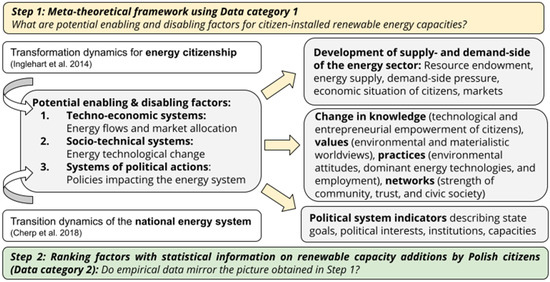
Figure 1.
Two-step research method, confronting two types of empirical data. Data category 1 describes the Polish energy system (see Table 1). Category 2 has empirical data on citizen-installed renewable energy capacities (Table 2) [20,21].
The meta-theoretical framework draws from different lines of research, namely research studying the transformation of societal dynamics at the individual level and the transition of the energy sector at the national level.
Our choice for the first line of research is the work pioneered by Inglehart et al. 2014, specifically, the empirical investigations made possible by different waves of the World Value Survey (short: WVS). This global survey started in 1981, reporting changes in individual values and beliefs worldwide through standardized questionnaires. Poland has participated in Wave 2 (1990–1994), Wave 3 (1995–1998), Wave 5 (2005–2009), Wave 6 (2010–2014), and Wave 7 (2017–2021). For this paper, we have screened all questions and selected those that relate to values and beliefs connected to the environment, relationships between individuals and their governments, and the state of the civil society. The rationale behind this selection is that the answers help shed light on the prospects for individuals to become energy citizens [31].
The second line of research that we build our analysis framework on connects to the tradition of energy system research to reveal path dependencies of the system and its interlinkages with other systems. In this paper, we utilize the meta-theoretical framework to analyze national energy transitions as proposed by Cherp et al. [21]. The paper also provides a substantial review of the relevant literature. The authors distinguish between three co-evolving systems (or perspectives) where change manifests. The first is the techno-economic system that focuses on energy flows and their coordination through economic markets. Electricity and resource markets are of particular interest to our paper. Top-level variables characterizing the first perspective are national resources, demand, and infrastructure. The second perspective is the socio-technical one, striving to understand how technological change occurs through changes in related knowledge, practices, and networks. Here, we add changes in values and beliefs, as they are essential to understanding why individuals change their behavior and actions. As pointed out in the introduction, the value and belief systems of former Eastern Bloc countries may be essential to understand today’s citizen engagement, which is why we put equal emphasis on both lines of research. Top-level variables of the socio-technical systems are innovation systems, regimes and niches, and technology diffusion. In the context of this paper, we focus on the emergence and diffusion of renewable energy technologies that are suitable for citizens (lay persons). The third perspective in Cherp et al. [21] is the systems of political action that shape national energy-related policies. Top-level variables describing it are state goals, political interests, and institutions and capacities.
Combining ideas from both lines of research, we elicit potential enabling and disabling factors for citizen-installed renewable energy capacities (step 1, see Section 3). Appendix A.1 presents this list and the likely causal links and variables for the empirical study of stylized developments. For example, poor national energy resource endowment and the domination of the primary energy mix by just one technology cause strong lock-ins of the energy system. As a result, they may act as barriers for a transition from centralized, monopolistic/oligopolistic energy markets to decentralized, many-actor ones. Only the latter provides a favorable environment for citizens to engage in the energy transition. Table 1 summarizes our choices for system variables, along with our sources (Data category 1).

Table 1.
Overview of variables and sources for Data category 1. The three co-evolving systems as well as the topics are based on Cherp et al. [21] and Inglehart 2014. For abbreviations, see Appendix A.1.
In the second step, we confront the picture obtained from the literature-inspired analysis with compiled data on the actual involvement of citizens in installing renewable energy capacities (see Section 4). Data category 2 sources from the Comets project inventory on collective action initiatives in the energy transition [30]. The Comets project inventory includes information on the number and type of initiatives and number of installed capacities (if available). Refer to Section 4 for documentation of sources.
3. Discussion of Results
3.1. Techno-Economic Systems Analysis
The analysis in this section strives to shed light on potential enabling or disabling factors that mainly arise from the techno-economic system, which is why we provide an overview of the Polish energy balance and energy market conditions. Despite significant societal changes and leaving aside absolute changes in energy flows, the overall balance of energy production and consumption in Poland has been very stable between 1973–2018 [33], owing to an unvarying primary energy mix. Indeed, the relatively static Polish Sankey diagram over many decades hints towards persistent energy technology lock-ins, overall low flexibility of the Polish energy system, and, hence, rather unfavorable conditions for citizens to take a seat among the established actors in the near future.
Poland is endowed with coal resources but lacks oil and conventional natural gas resources. Coal has been and continues to be the dominant primary energy resource (1973: 84.0%, 2018: 49.3%), followed by oil (1973: 9.6%, 2018: 23.9%) and natural gas (1973: 5.1%, 2018: 17.9%). As of today, other fuels are altogether marginal, with biofuel and waste production being the most common. The unimportance of renewables is at odds with Poland’s renewable energy resource potentials, among which wind energy is the greatest. Annual average wind speeds are relatively high and evenly distributed over the whole country, which means Poland ranks high among European countries for the deployment of wind energy [34]. On the other hand, the solar potential is relatively modest, with 1100–1300 kWh/kWp [35] as the hydropower potential [36]. While coal and gas primarily fuel the industrial and other sectors, oil is largely consumed in the transport sector. For the installation of renewable capacities by citizens, factors impacting electricity production are of significant importance. As of 2018, electricity production originated 80% from coal, followed by wind (7.7%), natural gas (7.6%), biofuels/waste (4.1%), and solar PV (0.2%), with diversification rising slowly since the 2000s. Thus, again, we see that the Polish power sector, like the energy sector in general, is characterized by a continuously high reliance on domestic coal resources along with the corresponding dominant energy infrastructures built around big actors, including the importance of the mining sector.
Antosiewicz et al. [37] recently carried out a modeling exercise to assess economic risks for the future Polish power sector under different scenarios. For the decarbonization scenario, the authors see a drastic reduction of coal by mid-century, dropping by more than 60%. In this scenario, coal is replaced roughly equally with wind, biomass/biogas, and nuclear energy, the latter only to be ramped up from 2030. Furthermore, electricity imports are foreseen to largely cover the expected growth in electricity demand. Notably, the cost-efficient pathway does not predict a prominent role for solar PV. With their scenario, the authors instead hint towards a continued reliance of the energy system on large-scale energy production technologies; in other words, a continued hindering of entry points for small-scale actors, even in the event of a decarbonization scenario.
Energy production in the country has been steadily decreasing since 1973, roughly halving to about 2.6 EJ in 2018. At the same time, Poland increased its imports (mainly of oil and gas), raising the country’s overall import dependency (Figure 2). However, with just above 40%, Poland still ranks quite low among the Visegrad countries. At the same time, continued growth of import dependence may create pressure to open up to alternatives in the energy production system to reduce the country’s exposure to energy price volatility.
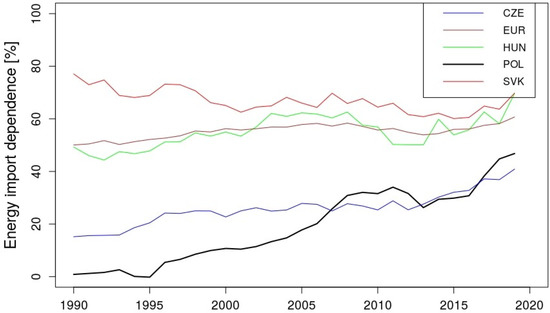
Figure 2.
Import dependency (1990–2019). Source: EUROSTAT [38].
The energy intensity of GDP and the cost of energy imports compared to GDP serve as common indicators. Figure 3. shows that GDP intensity has been decreasing over the years in line with the development in other Visegrad countries. It is a generally observed trend in the global north, originating from a structural change in the economy towards less-energy intensive sectors [39]. On the other hand, the relative cost of energy imports is increasing in Poland (Figure 4), which together with the following factors add substantial adaptation pressure on the Polish energy system. First, the demand for energy (and electricity in particular) is likely to continue to grow in the future. Indeed, final energy consumption had increased from about 2.5 EJ in 1973 to 3.1 EJ in 2018. Electricity demand has also grown; by more than 30% in the last two decades, reaching 167 TWh as of 2018. Furthermore, the outdated energy infrastructure ([40] p. 21) and the increase in power plant losses (coal input) from 49% in 1973 to as much as 55% in 2018 clearly show that the Polish power sector needs modernization to keep up with the decreasing costs of competing energy technologies.
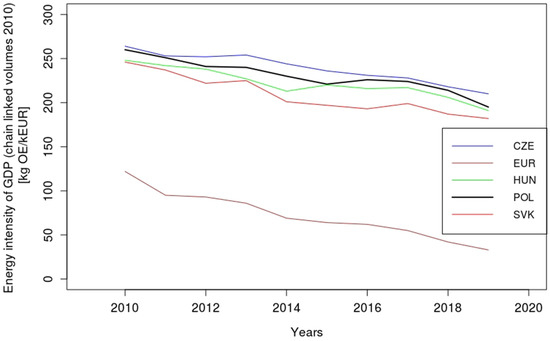
Figure 3.
Energy intensity of GDP (2010–2019). Source of data: EUROSTAT [38].
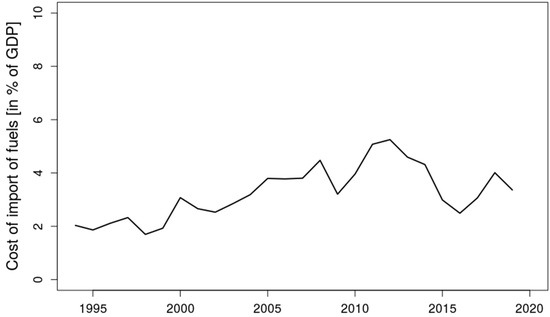
Figure 4.
Cost of energy imports compared to GDP (1994–2020). Source of data: EUROSTAT [38].
Indeed, the energy market in Poland (and other Visegrad countries) is in transition from a state-dominated, centralized one towards a decentralized energy market [41]. Figure 5 represents this trend by showing the growing number of electricity generating companies (representing at least 95% of the national net electricity generation). As a result, opportunities for new energy technologies and market actors continue to rise.

Figure 5.
Economic power in the energy market (2004–2019). Source: EUROSTAT [38].
The growing pressure on the Polish energy system to adapt to changing markets, develop cost-efficient energy production and distribution infrastructures, and pursue the low carbon energy transition meets with a less encouraging economic environment for households to consider engaging in the energy markets. As Figure 6 shows, household savings in % of disposable income per household are only slowly improving after a stark two-decade decline since 2000. Yet, sufficient resources are a prerequisite for citizens to invest economically. The figure shows that Poland is situated at the bottom, compared to other Visegrad countries. At the same time, the slow but steady increase in the electricity price, together with the fact that Polish households spent about twice as much on energy services (electricity, gas, and heat) as the average EU citizen, may constitute an incentive for citizens to invest into renewable energy capacities (Figure 7).
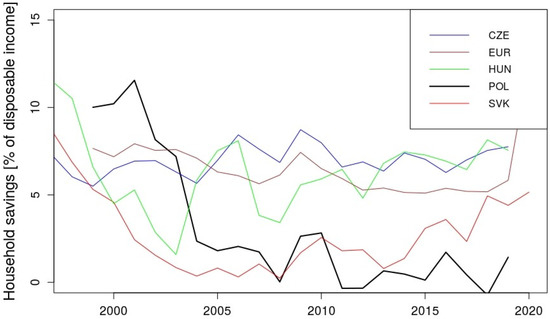
Figure 6.
Economic situation of citizens (1998–2019): Household savings. Source: EUROSTAT [38].
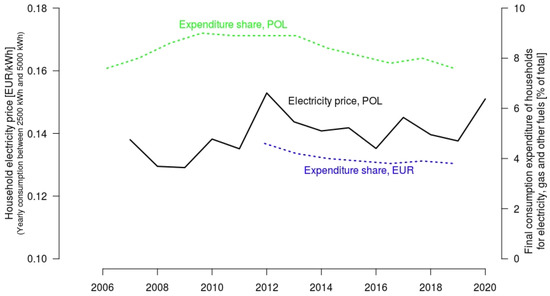
Figure 7.
Share in electricity expenses. Source of data: EUROSTAT [38].
Altogether, the analysis of the techno-economic system suggests that disabling factors rule the picture. Nevertheless, some emerging trends may break the strong path dependence of the Polish coal-dominated energy system in the future. For these reasons and at this point, we expect to observe a low number in the capacities of citizen-installed renewable energy, and could forecast a modest potential for future opportunities. Continuing the investigation to scrutinize observations so far, the following sections look into the two other perspectives beyond the techno-economic, beginning with socio-technical systems.
3.2. Socio-Technical Systems Analysis
In this section, we focus on understanding how technological change is occurring, along with changes in knowledge, values, practices, and networks. Therefore, variables for the socio-technical systems which we select are related to innovation systems, regimes, and niches, and technology diffusion for RE [21]. We study the dynamics occurring in Poland and compare them with other EU countries. As a benchmark, we mainly focus on the group of Visegrad countries. The rationales for choosing variables representing relevant knowledge, values, practices, and networks are as follows.
First, we look into the educational and technical background of citizens, having in mind that high levels generally foster the planning and operation of RE projects. Furthermore, we assume that high degrees of application and impact of ICT, as well as the prevalence of an entrepreneurial culture (or a positive attitude of citizens towards being entrepreneurs), contribute to favorable conditions for starting and managing citizen-led energy projects. Our hypothesis connects with research about the positive correlation of education with other indicators of social well-being. For example, better schooling systems resonate with more democratic politics [42], stronger economic growth links to high human capital [43] and greater education also impacts public health positively [44]. As proxies for our empirical analysis, we use the results of the PISA study in 2018 (for the general educational background), the Network Readiness Index (for the technological background of citizens and entrepreneurs), and the International Entrepreneurship Development Index (as an indicator for an entrepreneurial culture). As knowledge is the basis for any entrepreneurial activity, we explore the structural development of employment. For example, a high number of people working in knowledge intensive sectors also increases the base of skilled and educated citizens able to plan and operate renewable energy projects. Furthermore, changes in employment in the energy sector shed light on the speed of the sector’s transformation.
Next, we discuss selected societal values. We assume that public acceptance of the low carbon energy transformation cannot take place without a greater emphasis on post-materialist values in a society and an overall attitude towards preferring the state of the environment over economic growth [45]. Since shared values find their reflection in socio-economic practices and social networks, we assume that the higher the number of people who are members of environmental organizations, identifying themselves as part of their communities, and participating in civil society, the larger the pool of potential citizens to engage in the energy transition. Furthermore, social commitment is inseparable from social trust, which is why we also look into this matter.
The results are the following. As shown in Figure 8, Poland clearly stands out among EU-27 and Visegrad countries in PISA study results for young people (15–16 years). The values are highest in mathematics, reading, and science. These results from 2018 continue the trend break that began in 2000.
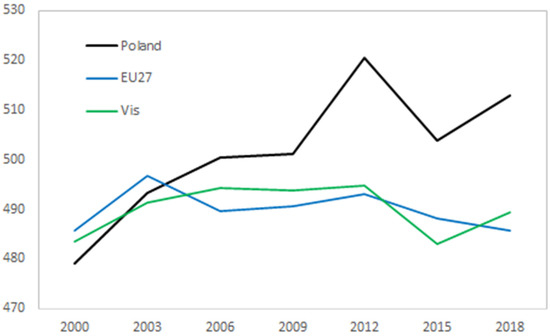
Figure 8.
Dynamics of educational background. Results from the PISA 2000–2018 study. Source of data: EUROSTAT [38].
The Network Readiness Index for Poland, EU-27, and Visegrad countries is shown in Figure 9. We find that Visegrad countries and Poland systematically score lower than the EU-27 average for the dimensions ‘technology’ and ‘people’. According to the country report [32], Poland scores particularly high in 4G mobile network coverage, internet access in schools, and e-commerce legislation, whereas the country scores low for internet bandwidth, use of virtual social networks, and investment in emerging technologies. Both dimension scores result in overall lower impact and total scores for all Visegrad countries. Only the dimension ‘governance’ is comparable to the EU-level. We conclude that the direction of digital transformation in Poland (and Visegrad countries) is dominated by top-down processes, owing to the state’s dominant role in creating regulations and solutions; here, to ensure security and a high level of competitiveness of IT service markets.
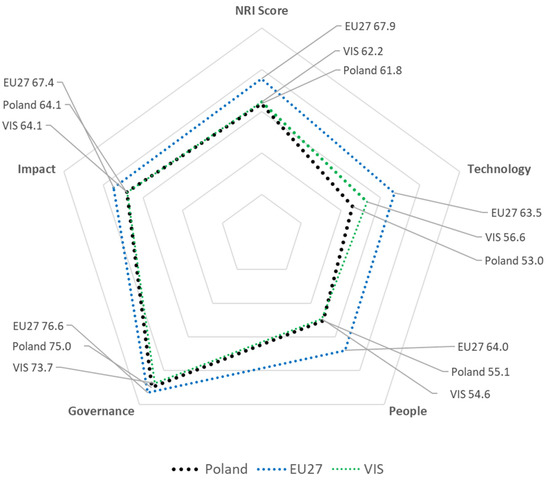
Figure 9.
Technology knowledge of citizens represented by scores for the Network Readiness Index (NRI) on the national application and impact of ICT. Source: WEF 2020 [46].
Thus far, the results hint towards mixed conditions for observing citizen-installed RE capacities. We next review the prevalence of an entrepreneurial culture, using the International Entrepreneurship Development Index (Figure 10) and its breakdown into sub-indices for the year 2020 (Figure 11). Figure 10 shows that Poland is below the EU-27 average but higher than the group of Visegrad countries. Poland’s relative strengths include startup skills (measured in percentage of the population believed to have adequate startup skills), product innovation and cultural support (Figure 11). On the other hand, risk acceptance, technology absorption, and process innovations are weaker spots.
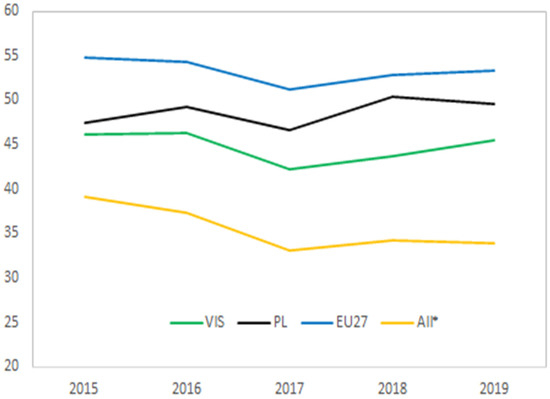
Figure 10.
International Entrepreneurship Development Index (2015–2019). Source: GEDI [47].
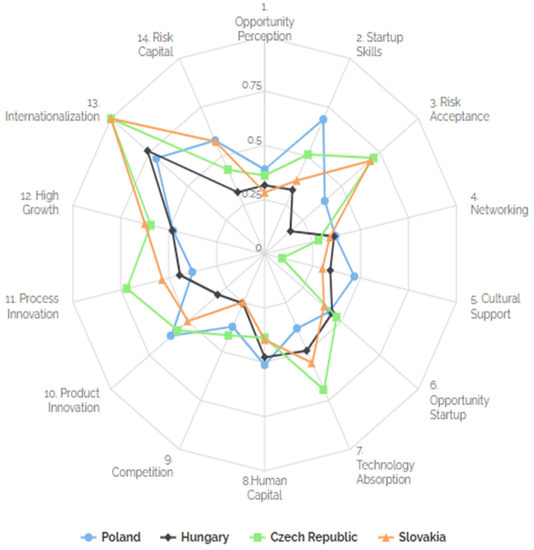
Figure 11.
Sub-indices of the International Entrepreneurship Development Index, breakdown for the year 2020 [47].
Figure 12 illustrates, respectively, that Poland has a relatively small workforce employed as ICT specialists as well as in high-tech manufacturing. Notably, the numbers are significantly lower compared to all other Visegrad countries. Ceteris paribus, this fact should coincide with lower numbers of citizen-installed capacities in Poland if these factors possess explanatory power.
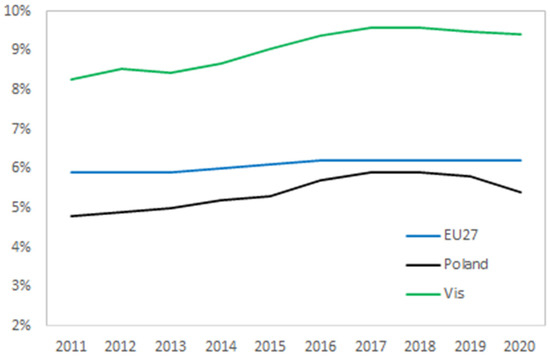
Figure 12.
Human resources in science and technology. Employment in ICT sector and technology manufacturing. Percentage of total employment. Source of data: EUROSTAT [38].
At the same time, Poland has one of the highest employment rates in the energy sector in Europe (Figure 13). We follow the NACE classification, summarizing employment in ‘electricity, gas, steam and air conditioning supply’ and ‘mining’. The percentage of employees working in the sector is more than twice as high as in other Visegrad countries and has significantly increased since 2017. The increase originates from a growth of employment in the mining sector with a simultaneous decline in production. Derski reported [48] three reasons for that, which are geological conditions that require more human labor, relatively high coal prices that encourage new investments, and a shift from external services to employment within the country for political reasons. In light of the discussion in Section 3.1 and Section 3.3 on the strong role of the state and the stark persistence of energy system lock-ins in Poland, we believe that this indicator is an important one for explaining the likelihood of citizen-installed renewable capacities.
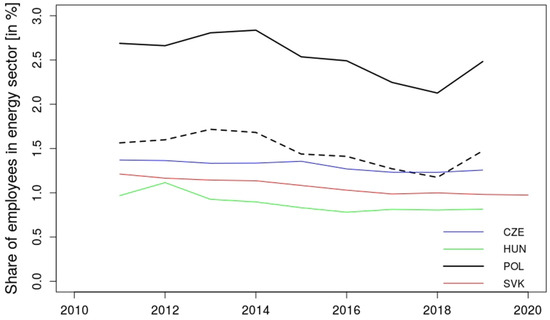
Figure 13.
Share of employment in the energy sector vs. all employment (2011–2019/2020). NACE classification, employment in the sectors ‘electricity, gas, steam and air conditioning supply’ and ‘mining’ (also shown separately as dashed line). Source: EUROSTAT [38].
An analysis of the development of market shares of energy technologies in the past decades confirms the overall picture. Figure 14 shows the market ratio of fossil and renewable primary energy carriers f (as f/(1 − f)) over time in a semi-logarithmic plot (Fisher–Pry graph). Notably, renewable energies that would be accessible to citizens only carve out a niche existence, having well below 5% market shares. On the other hand, coal, oil, and gas together take the lion’s share, and little has changed over the past three decades. Clearly, this constitutes a disabling factor for vibrant, multi-actor renewable capacity markets.
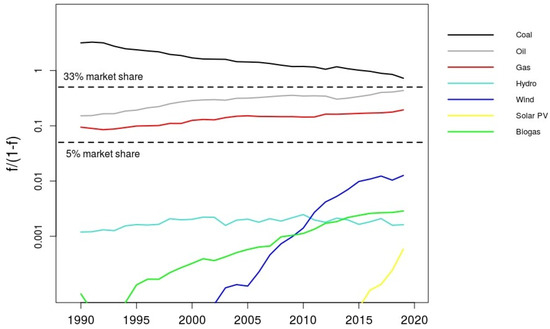
Figure 14.
Market shares of energy technologies f between (1990–2019). Source of data: EUROSTAT [38].
Next, we turn to the discussion of selected societal values. We start with values towards materialism and post-materialism, in which freedom of expression and participation in decision-making constitute a crucial element ([49], p. 1). We believe that a stronger tendency towards post-materialistic values also coincides with attitudes towards participation in the energy transition. As can be inferred from Figure 15, for most of the past few decades, Poland has gravitated towards a group of countries where materialist values are more important than post-materialist ones. More specifically, Poland is located between Western European countries (where post-materialism dominates) and the majority of the Eastern bloc (where materialistic values continue to be more important). Nevertheless, the slowly changing trend in Poland observed from Wave 6 of the WVS [50] indicates that the struggle for day-to-day survival following the collapse of the Iron Curtain is coming to an end. The focus on economic development and physical security broadens by also embracing less materialistic values.
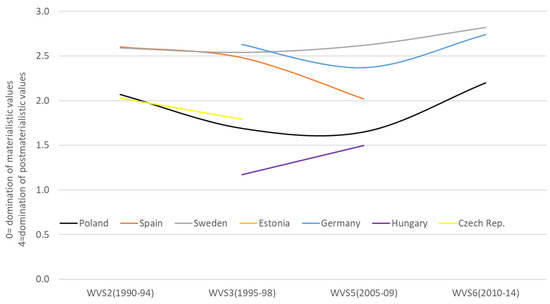
Figure 15.
The development of the post-materialist index. Source of data: WVS, Waves 2–6.
The domination of materialistic values may indicate why in Eastern European countries, and especially in Poland, the engagement of citizens in the energy transition is more likely steered towards the achievement of economic goals (such as lowering energy costs or increasing energy convenience cost) rather than normative ones (such as reaching climate change targets or ensuring energy-democracy). Additional empirical data from the WVS and the Varieties of democracy projects shed more light on these aspects [50]. As data on the relative weight of the environment versus economic growth presented in Table 2 show, Polish citizens prioritize the latter. Moreover, the majority also answers the question ‘How much confidence do you have in the Environmental Protection Movement?’ with ‘less confident’, which is a different picture than those obtained from the answers of Western European citizens (here: Sweden and The Netherlands; see Table 2). At the same time, Polish citizens feel they are part of the local community, a value that could facilitate collective renewable energy communities.

Table 2.
Values towards environmental protection and local community. Data source: WVS [50].
On the other hand, survey data obtained from the Varieties of Democracy project [51] reveal a strong connection between civic engagement (as measured by the civil society participation index) and political system changes; refer to Figure 16. During the early 1980s, the period of temporary liberation of trade union membership was visible, followed by a stark growth in civil society after the collapse of the Eastern Bloc after 1990. At that time, Polish civil society was indexed above the average for the rest of Central and Eastern Europe, and even above the European Union. However, after 2014, we see a significant drop in the index. At present, the levels of indicators concerning the condition of civil society are below the levels for other countries in Central and Eastern Europe, which may indicate barriers to citizen-led renewable capacity projects.
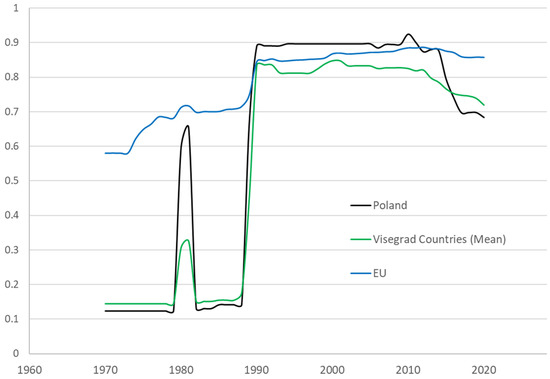
Figure 16.
Civil society participation index. Source of data: VDEM [51].
Another barrier concerns the low ranking of Poland in the WVS regarding trust towards other people (Figure 17). Only one-third of Polish citizens trust strangers and roughly just the same number believe that trust in business generally pays off [52]. In general, Poland, as a post-communist country, is facing the problem of low social capital (low civic engagement) and strong in-group solidarity [53]. This generates a culture of distrust, and also leads to the generation of negative social capital. Overall, we therefore expect that in Poland the motivation for citizens to install renewable capacities is hampered and—if existing—should have a strong materialistic dimension.
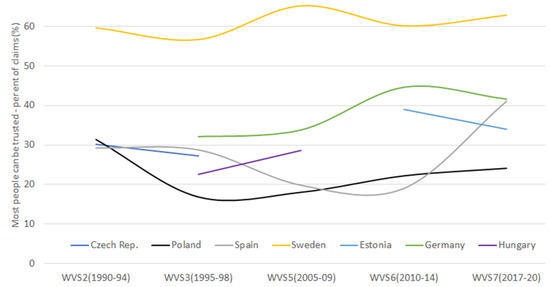
Figure 17.
Level of trust in other people (1990–2020). Most people can be trusted (percent of claims). Source: WVS, waves 2–7 [50].
3.3. Analysis of Systems of Political Actions
The analysis of the system of political action focuses on state goals, political interests (industrial lobby groups, social movements, public preferences) as well as institutions and capacities (refer to Cherp et al. for more details [21]). Drawing from a systematic review of Polish energy strategies (see Appendix A.1 for the list) and a discussion of political system indicators, we narrow our analysis to the factors that are in our opinion significant for the development of citizen-installed renewable energy capacities.
Given the endowment of natural resources, national energy security is and has been the pivotal goal of the Polish Government [5]. As of today, electricity continues to be mostly fueled by domestic coal and lignite resources (see Section 3.1); and the respective lobbies benefit from the status quo [54]. These concern state-owned corporations as well as coal and lignite-mining labor unions [55]. The influence of interest groups is in some ways tremendous. For example, the ruling political parties used lucrative energy companies to reward their political allies with well-paid professional positions in the energy sector [56]. In addition, the numerous labor unions represent significant voting and political power, influencing political decisions concerning the energy market [55].
After the cold war, the most important point on the political agenda was to change dependency on Russian gas. Historical experiences are crucial in this context. The fear of Russia being able to abruptly cut off the supply of gas as a part of the political game created a security paradigm in Poland evident in the country’s energy strategies. Most importantly, domestic coal resources are perceived as a national treasure [6]. Nevertheless, the process of lowering dependence on Russian gas has been slow. In 2016, 89% of the national gas supply still originated from Russia, approaching 60% in 2018 [57]. The hope surrounding shale gas is another example of the country’s striving for energy independence. Shale gas was predicted to become a ‘game-changer’. After the publication of promising estimates of resources in 2009, the media was full of optimism about the prospects, but the story found an abrupt end around 2017 due to the reluctance of investors caused by legal chaos and unfavorable tax regulations [58]. The support of state ownership in the energy market is seen as essential and, hence, the role of citizens in the energy transition, individually or in small collectives, is limited [59].
In its National Energy Strategy for 2040, the government nevertheless aims to reduce reliance on fossil fuels, but without undermining the centralized structure of the energy sector [40]. The strategy implies reducing coal for electricity production (<56%) and increasing the share of RE (>23%) by 2030. The strategy also sets technology goals, i.e., for installing up to 6 GW of nuclear power capacities, 16 GW for PV, and 11 GW for offshore wind by 2040. The planned development of a nuclear power infrastructure by 2033 will further solidify the centralized energy infrastructures. In other words, the role of prosumers is only seen as a support for the centralized energy system, and not as a means of decentralization and democratization of the energy markets.
While some support for individual self-consumers, agribusinesses, and other private entities exist to encourage engagement in the energy market, the possibilities for collective action in the energy sector are overall limited compared to other European countries [59]. Table 3 gives an overview on recent programs that support investments (mostly limited to the PV sector) through tax exemptions, investment subsidies, and other measures. This governmental support is relatively recent, supporting for the most part only self-consumption, and only few legally formalized options for citizen-led energy projects exist. Legal options include housing cooperatives and communities, energy cooperatives, energy clusters, small-scale energy sharing initiatives (partly non-formalized), private and public limited partnerships, NGOs, or associations (e.g., to create a common platform for joint investment into RES). Notably, the Polish government favors the development of energy clusters (a specific form of civic agreement between entities—often local communities and businesses—that set a goal for energy self-sufficiency) over energy cooperatives which are a main driver of citizen-led RE projects in other European countries (e.g., Wierling et al., 2018, [2])

Table 3.
Overview of current support schemes for individual or collective prosumer activities.
Many of these organizational forms face stricter regulations compared to similar forms in other EU countries. One major barrier is, for example, that energy cooperatives can only operate in rural or urban-rural areas [62]. This is restrictive because the pool of people supporting climate change mitigation and a larger role of RE in the energy mix are mainly located in cities [68]. Residents living in a multi-family building are allowed to make a collective investment into RE but electricity can only be used for powering the shared parts of the building [62]. Most importantly, the current limit for RE capacity additions is capped at 50 kW (micro installations for electricity self-consumption), 50–500 kW (small installations for self-consumption or selling through an auction system as a primary business activity), and up to 600 kW (only for business purposes). The caps pose challenges in developing sufficient market power for incumbents. Moreover, regulatory barriers make investment difficult. An obvious example of a piece of legislation that stopped the dynamically developing wind energy market was the implementation of the Act on Investments in Wind Farms in 2016 [69], which drastically limited suitable locations because the distance from settlements has to exceed 10 times the height of a windmill. Last but not least, the sale and feeding-in of electricity to the grid by individual and collective prosumers is prohibited; any such economic activity is not allowed according to the Act on the Freedom of Economic Activity from 2004 [54]. Surveyed by Pietrzak et al. [70], experts emphasize the need for major legal changes, public education, and awareness raising about RE technologies, and a broadening of financial incentives and tax exemptions.
Next, we take a closer look into the spheres of social and political activities, as the energy transition is not only a regulatory, technological, and economic issue [71]. We review indicators of participatory democracy, liberal law, and confidence in institutions, as they enable social innovations [72,73,74]. Social innovations, which are becoming more and more important [75,76,77,78,79] in the energy sector, open up future perspectives to changing the role of citizens from passive energy consumers to active participants in the energy market. Often, these are driven by collective actions [26].
Since 2015, the Polish political system is significantly changing due to legal changes implemented by the Law and Justice party. These developments clearly show up in the trends for the liberal democracy and rule of law indices (Figure 18 and Figure 19). Both of them show a decline since 2015. Note that this is not just the case for Poland but for all Visegrad countries. As regards the long-term trend in confidence towards institutions, Poland also ranks low [50]. We claim that confidence towards selected institutions mimics the level of trust towards public and private entities in general. We use it as an indicator for the effectiveness of government support schemes and educational/promotional programs supporting RES technologies. Figure 20 shows that the indicator dropped continuously from 54% (wave 2) to 43% (wave 6) and 38% (most recent wave 7) [50]. We connect these negative trends with a disabling environment for citizen RE projects.

Figure 18.
Rule of law. Source of data: VDEM [51].
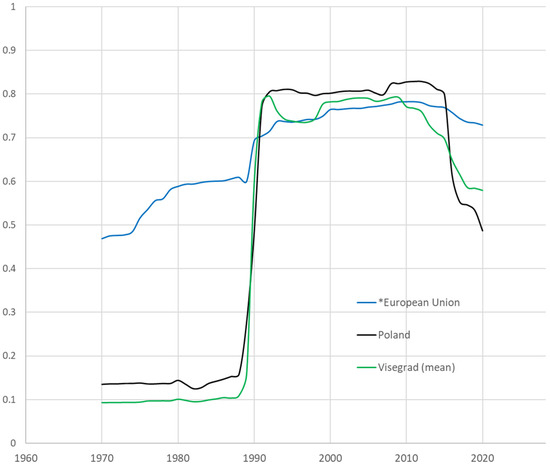
Figure 19.
Liberal democracy index. Source: VDEM [51].
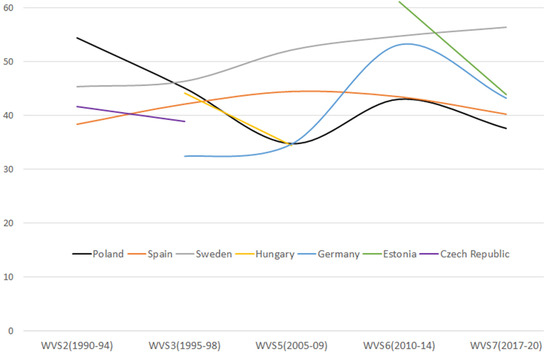
Figure 20.
Confidence in institutions. Source of data: WVS [50].
3.4. Empirical Data on Individual and Collective Prosumers in Poland
The analysis so far has revealed a range of enabling and disabling factors for citizen-installed renewable capacities that originate from past and current states of the techno-economic system (Section 3.1), the socio-technical system (Section 3.2), and the systems of political action (Section 3.3). We next confront the analysis that draws from statistics, reports, and governmental documents with actual data on renewable capacities added by Polish citizens and information obtained from surveys within the EU project Comets.
Table 4 reports the data compiled and/or estimated for four main prosumer categories that are typical for Poland, i.e., individual prosumers, housing cooperatives and associations, energy clusters, as well as energy cooperatives. All of them are rather recent and PV is the preferred technology (making up more than 90% of capacity additions). Altogether, we estimate the contribution by individual and collective prosumers in Poland to amount to roughly 3.2 GW (see Table 4 for uncertainty ranges). This is small in size when compared to other European countries (c.f., [2,80]). However, the sector is slowly growing and Polish energy markets continue to open up for non-incumbents as laws and regulations fostering the national energy transition are being implemented, including EU Directives 2018/2001 [1] and 2019/944 [7].

Table 4.
Current renewable capacity additions by Polish citizens. Type of activity, estimates, motivations, and identified barriers from the database and interviews [30].
The number of active citizens and/or initiatives amounts to about 460,000; most of them are contributions by individuals. In total, 112 collective prosumer initiatives have formed, with the majority being regional energy clusters [83,84], which are the favored form by the Polish government (see Section 3.3). Notably, only one energy cooperative exists. This finding distinguishes the development of citizen energy in Poland from that of most Western European countries where energy cooperatives are one of the—or even the most—important legal form of citizen-led energy projects. Regarding the motivation for engaging in the production of renewable-based electricity, we find that economic incentives rank highest, followed by the goal of achieving energy self-sufficiency. The result echoes the findings obtained when analyzing the energy system and its connected values and practices by citizens (Section 2). In addition, energy clusters also seek to realize regional/local business opportunities that come with networking and engagement in the energy sector.
4. Conclusions
Our paper summarizes barriers and enablers for citizen-led renewable energy investments and provides a novel scientific method of ranking enabling and disabling factors. The following section can be helpful for policymakers and many social actors, seeking the answer about the perspectives of development of citizen-installed renewable energy capacities in Poland and other former Eastern Bloc countries.
The currently rather small size of citizen-installed renewable capacities and the modest number of collective initiatives in Poland are due to a number of barriers. Table 5 concludes by ranking enabling and disabling factors, following from confrontation of the analysis of the national energy system (Section 3.1–3.3) with empirical data compiled for individual and collective prosumers in Poland (Section 3.4). Overall, we find that the high number of disabling factors coincides with the marginal role of citizens in the energy transition in Poland. We differentiate between ‘(mostly) disabling’, ‘(mostly) enabling’, and ‘mixed’ factors. High energy intensity of the energy sector is an example of a ‘mixed’ factor. On the one hand, incentives are high for the sector to improve, also to be able to compete in international markets as energy is an important cost factor. On the other hand, high base load requirements to fuel energy intensive sectors are challenging to provide with renewable energy only, which, therefore, speaks in favor of replacing base load currently generated from coal by gas, oil, or nuclear in the future.

Table 5.
Ranking of enabling and disabling factors. * including electricity prices.
As described in the Section 2 (Materials and methods), the authors, after a deliberative discussion, prescribed the importance of each factor by indicating the number of assigned weights, i.e., factors with three crosses matter most, whereas a single cross symbolizes that the factor is seen as less important after discussion among the authors. In addition to the current state, Table 5 also indicates the identified future trends.
The factors with highest explanatory power for describing the current restrained engagement of prosumers in Poland are connected with its decades-long rigid, centralized energy system that goes hand in hand with social, regulatory, and technical lock-ins established around domestic coal production. Indeed, most interview respondents found it difficult to imagine a transition to a less centralized energy system in the near future [5]. While renewable energy technologies are slowly entering the markets and opportunities for citizen-led energy projects are rising, the government continues to solidify the centralized energy system (e.g., by building up nuclear capacities, by steering investments towards a limited number of technologies, by supporting selected societal groups). Moreover, the preferred choice of supported non-incumbents in the energy market are energy clusters, which are more of a means for local business development (with some possibilities for citizens to engage) than a pursuit of citizen-led energy initiatives (e.g., eco-villages, energy cooperatives, and other more common legal forms in other European countries).
Strikingly, factors connected with the heritage from the socialist phase and repercussions following the fall of the Eastern bloc are less important for understanding the overall picture of the Polish prosumer sector. However, these factors confirm the generally disabling environment for citizen-installed renewable capacities and they also explain why we find substantially more contributions from individuals than from collective prosumers. First, the motivation for engagement in Poland is typically an economic one and not as much driven by post-materialist values. Second, individuals can already profit from RE installations through achieving self-sufficiency. This is not the case for collective prosumers and their sustained engagement in the energy market. The legislative environment creates high entry-barriers and is hindering sustained activities of citizens in the energy sector. This is either due to a lack of regulation or because of laws limiting the prospects of activities beyond self-consumption, i.e., the successful deployment of business models. For example, business opportunities for collective prosumers are limited as energy cooperatives need to cover 70% of the annual electricity demands of their members. Third, the low level of trust in society is a disadvantage for successfully investing into RE technologies, as costs are still (relatively) high and collaboration with other members of the society (e.g., neighbors) is hampered.
Nevertheless, the EU, in its role of an initiator and executive with power to steer developments, is also an important factor (see Table 5). Indeed, the National Energy Strategies recognize the important role of European institutions for policy planning and decision-making. Currently, the country is implementing Directives (EU) 2019/944 [7] (on common rules for the internal market for electricity) and Directive (EU) 2018/2001 [1] (on the promotion of the use of energy from renewable sources). Both directives are meant to strengthen the active role of citizens in the energy transition by setting the ground for ‘rules allowing consumers to produce their own electricity, individually or as part of renewable energy communities, without undue restrictions’. Furthermore, the idea of ‘energy democracy’ [85] is also spreading in Poland (c.f. [10]) Benefiting from low prices in PV markets and from governmental incentives, the market share of decentralized energy technologies and the number of actors in the energy market is rising. In the future, they also have the potential to shift the distribution of political power.
While this paper helped to shed light on the Polish context through a new comprehensive analysis framework, future research has to be undertaken to further scrutinize the meta-theoretical framework in the context of other countries. It has to be tested to what extent it is possible to elicit essential variables that may serve as a fingerprint for understanding the development of citizen-led installed renewable capacity additions across Europe. The revisions should also help to eliminate remaining subjectivity in the discussion and ranking of the list of disabling and enabling factors.
5. Policy Impact
The identified enabling and disabling factors that are shaping the development of citizen-installed renewable energy capacities in Poland is a promising path both for researchers, policymakers, as well as for many social actors that are crucial for the development of the energy transition policies on both the national and EU level. Our three-level approach compares the techno-economic system, the socio-technical system, and the system of political actions, which together can be promising for designing future energy policies in Poland and other countries.
As is shown in Table 5, only the socio-technical system shows a positive trend that could enable citizen-led investments in renewable energy. Both the techno-economic system and the system of political actions require a lot of changes that need to be implemented to ensure more civic engagement into the energy system transition.
Author Contributions
Conceptualization, V.J.S., T.J.R., W.H. and A.H.W.; methodology, V.J.S.; investigation, V.J.S., T.J.R., W.H. and A.H.W.; writing—original draft preparation, V.J.S., T.J.R., W.H. and A.H.W.; writing—review and editing, V.J.S., T.J.R., W.H. and A.H.W. All authors have read and agreed to the published version of the manuscript.
Funding
The research was accomplished under the COMETS project (COllective action Models for Energy Transition and Social Innovation funded by the Horizon 2020 Framework Program of the European Commission, grant no. 837722.
Institutional Review Board Statement
Not applicable.
Informed Consent Statement
Not applicable.
Data Availability Statement
Not applicable.
Conflicts of Interest
The authors declare no conflict of interest.
Appendix A
Appendix A.1. Abbreviations of Data Sources
| EUROSTAT | Various data, see: https://ec.europa.eu/eurostat/data/database/ (accessed on 28 March 2020) |
| IEA Sankey | https://www.iea.org/sankey/#?c=Poland&s=Balance (accessed on 28 March 2020) |
| OECD | https://www.oecd.org/PISA/ (accessed on 28 March 2020) |
| PORTULANS | World Economic Forum, Network Readiness Index, see Dutta et al. 2021 |
| GEDI | Global Entrepreneurship Research Data 2015–2019, see https://thegedi.org/wp-content/uploads/2020/01/GEI_dataset_2006_2016.xlsx (accessed on 28 March 2020) |
| WVS | World Value Survey, see Haerpfer 2020; Ingelhardt 2014 |
| VDEM | Varieties of Democracies (V-DEM), see Coppedge et al. 2021; Pemstein et al. 2021 |
Appendix A.2. List of 19 Polish Energy Strategies That Were Used for the Analysis
- Ministerstwo Przemysłu (1990), Założenia polityki energetycznej Rzeczypospolitej Polskiej na lata 1990–2010. Ministry of Industry (1990), Assumptions for the Republic of Poland Energy Policy for years 1990–2010.
- Ministerstwo Energii (2017), Krajowy Plan Działań dotyczących efektywności energetycznej dla Polski 2017. Ministry of Energy (2017), National Plan for polish energy efficiency 2017.
- Ministerstwo Gospodarki (2009), Prognoza zapotrzebowania na paliwa I energię do 2030 roku, załącznik 2. Do Polityki energetycznej Polski do 2030 roku. Ministry of Economy (2009), Forecast for fuels and energy demands to 2030. An appendix for the Polish Energy Policy till 2030.
- Ministerstwo Gospodarki (2009), Program działań wykonawczych na lata 2009–2012, załącznik 3. Do Polityki energetycznej Polski do 2030 roku. Ministry of Economy (2009), Executive plan for 2009–2012. An appendix for the Polish Energy Policy till 2030.
- Ministerstwo Gospodarki Rzeczypospolitej Polskiej (2009). Ocena realizacji polityki energetycznej od 2005r. Ministry of Economy (2009). The evaluation of the execution of the polish energy policy from 2005.
- Ministerstwo Gospodarki (2009), Wnioski ze strategicznej oceny oddziaływania Polityki Energetycznej na środowisko, Załącznik 4. do Polityki energetycznej Polski do 2030 roku. Ministry of Economy (2009), Conclusions from the strategic evaluation of the influence of Energy Policy for the environment. an appendix for the Polish Energy Policy till 2030.
- Rada Ministrów (2014), Strategia Bezpieczeństwo Energetyczne i Środowisko perspektywa do 2020 r. The Council of Ministers (2014). Strategy for Energy Security and Environment, perspective for 2020.
- Kancelaria Sejmu(1997), Ustawa z dnia 10 kwietnia 1997 r. Prawo energetyczne. Chancellery of the Parliament, Act from 10 april 1997, Energy Law.
- Ministerstwo Gospodarki (2002) Ocena realizacji i korekta Założeń polityki energetycznej Polski do 2020 roku. Ministry of Economy (2002). The evaluation and adjustment for Polish energy policy till 2020.
- Ministerstwo Gospodarki i Pracy (2005), Polityka Energetyczna Polski do 2025 roku. Ministry of Economy and Labour (2005), Energy policy till 2025.
- Ministerstwo Skarbu Państwa (2003), Program realizacji polityki właścicielskiej Ministra skarbu państwa w odniesieniu do sektora elektroenergetycznego. Ministry of Treasury (2003), Programme for state ownership regarding the energy sector.
- Ministerstwo Skarbu Państwa (2005), Aktualizacja programu realizacji polityki właścicielskiej Ministra skarbu państwa w odniesieniu do sektora elektroenergetycznego (przyjętego przez RM w dn. 28.01.2003 r.). Ministry of Treasury (2005), An update for the programme for state ownership regarding the energy sector.
- Ministerstwo Gospodarki (2006), Program dla elektroenergetyki. Ministry of economy (2006), Program for the electro energy
- Ministerstwo Gospodarki (2009), Polityka energetyczna Polski do 2030 roku. Ministry of Economy (2009), Energy policy till 2030.
- Ministerstwo Gospodarki (2015), Projekt Polityki energetycznej Polski do 2050 roku. Ministry of Economy (2015), Draft of the Energy policy till 2050.
- Ministerstwo Energii (2017), Innowacje dla energetykI. Kierunki rozwoju innowacji energetycznych. Ministry of Energy (2017), Innovations for Energy market. Directions of energy innovations.
- Ministerstwo Aktywów Państwowych (2019). Krajowy plan na rzecz energii i klimatu na lata 2021–2030. Ministry of State Actives (2019). National plan for energy and climate for 2021–2030.
- Ministerstwo Klimatu i Środowiska (2021), Polityka energetyczna Polski do 2040 roku. Ministry of Climate and Environment (2012). Energy policy till 2040.
- Nowy Ład (2021) https://www.gov.pl/web/polski-lad. New Deal (2021). (accessed on 28 March 2020)
References
- KOWR. Wykaz Spółdzielni Energetycznych. 2021. Available online: https://www.kowr.gov.pl/uploads/pliki/DI/Spóldzielnie%20enrgetyczne/Rejestr%20spółdzielni%20energetycznych/Wykaz%20spółdzielni%20energetycznych_2021.05.11.pdf (accessed on 5 July 2021).
- Wierling, A.; Schwanitz, V.J.; Zeiß, J.P.; Bout, C.; Candelise, C.; Gilcrease, W.; Gregg, J.S. Statistical Evidence on the Role of Energy Cooperatives for the Energy Transition in European Countries. Sustainability 2018, 10, 3339. [Google Scholar] [CrossRef]
- European Commission. Directorate-General for Energy (European Commission): Clean Energy for All Europeans. 2019. Available online: https://op.europa.eu/s/pkgS (accessed on 29 June 2021).
- Sowa, J. Inna Rzeczpospolita jest Możliwa! Widma Przeszłości, Wizje Przyszłości; WAB: Warszawa, Poland, 2015. [Google Scholar]
- Rabiej-Sienicka, K.; Rudek, T.J.; Wagner, A. Let it Flow, Our Energy or Bright Future: Sociotechnical imaginaries of energy transition in Poland. Energy Res. Soc. Sci. 2018, 89, 102568. [Google Scholar] [CrossRef]
- Kuchler, M.; Bridge, G. Down the black hole: Sustaining national socio-technical imaginaries of coal in Poland. Energy Res. Soc. Sci. 2018, 41, 136–147. [Google Scholar] [CrossRef]
- Act on Investments in Wind Farms. Ustawa z dnia 20 maja 2016 r. o Inwestycjach w Zakresie Elektrowni Wiatrowych. 2016. Available online: https://isap.sejm.gov.pl/isap.nsf/DocDetails.xsp?id=WDU20160000961 (accessed on 5 July 2021).
- Jarosz, D. The Collectivization of Agriculture in Poland: Causes of Defeat. In The Collectivization of Agriculture in Communist Eastern Europe: Comparison and Entanglements; Iordachi, C., Bauerkamper, A., Eds.; Central European University Press: Budapest, Hungary, 2014; pp. 113–146. [Google Scholar]
- Szulecki, K. Conceptualizing energy democracy. Environ. Politics 2018, 27, 21–41. [Google Scholar] [CrossRef]
- Sweeney, S. Working toward Energy Democracy. In State of the World 2014. State of the World; Island Press: Washington, DC, USA, 2014. [Google Scholar] [CrossRef]
- Bukraba-Rylska, I. Socjologia wsi Polskiej; PWN: Warszawa, Poland, 2008; p. 347. [Google Scholar]
- Dzun, W. Proces transformacji gospodarstw osób prywatnych w latach 1990–1996. Zagadnienia Polityki Rolnej 2014, 2, 239. Available online: http://cejsh.icm.edu.pl/cejsh/element/bwmeta1.element.desklight-897f8841-4800-40a9-8357-932d77bacf52 (accessed on 1 December 2021).
- Beckmann, V.; Otto, I.M.; Tan, T. Overcoming the legacy of the past? Analyzing the modes of governance used by the Polish agricultural producer groups. Agric. Econ.–Czech. 2015, 61, 222–233. [Google Scholar] [CrossRef]
- Hewitt, R.J.; Bradley, N.; Compagnucci, A.B.; Barlagne, C.; Ceglarz, A.; Cremades, R.; McKeen, M.; Otto, I.M.; Slee, B. Social Innovation in Community Energy in Europe: A Review of the Evidence. Front. Energy Res. 2019, 7, 31. [Google Scholar] [CrossRef]
- Ruggiero, S.; Isakovic, A.; Busch, H.; Auvinen, K.; Falle, F. Community WORKING PAPER No. 2.3. Developing a Joint Perspective on Community Energy: Best Practices and Challenges in the Baltic Sea Region. Available online: http://co2mmunity.eu/wp-content/uploads/2019/03/Co2mmunity-working-paper-2.3.pdf (accessed on 5 July 2021).
- Capellán-Pérez, I.; Johanisova, N.; Young, J.; Kunze, C. Is community energy really non-existent in post-socialist Europe? Examining recent trends in 16 countries. Energy Res. Soc. Sci. 2020, 61, 101348. [Google Scholar] [CrossRef]
- Young, J.; Brans, M. Fostering a local energy transition in a post-socialist policy setting. Environ. Innov. Soc. Transit. 2020, 36, 221–235. [Google Scholar] [CrossRef]
- Żuk, P.; Żuk, P.; Pluciński, P. Coal basin in Upper Silesia and energy transition in Poland in the context of pandemic: The socio-political diversity of preferences in energy and environmental policy. Resour. Policy 2021, 71, 101987. [Google Scholar] [CrossRef]
- Jasiński, J.; Kozakiewicz, M.; Sołtysik, M. Determinants of the Energy Cooperatives Development in Rural Areas—Evidence from Poland. Energies 2021, 14, 319. [Google Scholar] [CrossRef]
- Inglehart, R.; Haerpfer, C.; Moreno, A.; Welzel, C.; Kizilova, K.; Diez-Medrano, J.; Lagos, M.; Norris, P.; Ponarin, E.; Puranen, B. World Values Survey: Round Six-Country-Pooled Datafile Version; JD Systems Institute: Madrid, Spain, 2014; p. 12. [Google Scholar]
- Cherp, A.; Vinichenko, V.; Jewell, J.; Brutschin, E.; Sovacool, B. Integrating techno-economic, socio-technical and political perspectives on national energy transitions: A meta-theoretical framework. Energy Res. Soc. Sci. 2018, 37, 175–190. [Google Scholar] [CrossRef]
- Sovacool, B.K. How long will it take? Conceptualizing the temporal dynamics of energy transitions. Energy Res. Soc. Sci. 2016, 13, 202–215. [Google Scholar] [CrossRef]
- Grubler, A.; Wilson, C.; Nemet, G. Apples, oranges, and consistent comparisons of the temporal dynamics of energy transitions. Energy Res. Soc. Sci. 2016, 22, 18–25. [Google Scholar] [CrossRef]
- Stirling, A. Transforming power: Social science and the politics of energy choices. Energy Res. Soc. Sci. 2014, 1, 83–95. [Google Scholar] [CrossRef]
- Yildiz, Ö.; Rommel, J.; Debor, S.; Holstenkamp, L.; Mey, F.; Müller, J.R.; Radtke, J.; Rognli, J. Renewable energy cooperatives as gatekeepers or facilitators? Recent developments in Germany and a multidisciplinary research agenda. Energy Res. Soc. Sci. 2015, 6, 59–73. [Google Scholar] [CrossRef]
- Gregg, J.S.; Nyborg, S.; Hansen, M.; Schwanitz, V.J.; Wierling, A.; Zeiss, J.P.; Delvaux, S.; Saenz, V.; Polo-Alvarez, L.; Candelise, C.; et al. Collective Action and Social Innovation in the Energy Sector: A Mobilization Model Perspective. Energies 2020, 13, 651. [Google Scholar] [CrossRef]
- Campos, I.; Marín-González, E. People in transitions: Energy citizenship, prosumerism and social movements in Europe. Energy Res. Soc. Sci. 2020, 69, 101718. [Google Scholar] [CrossRef]
- Wierling, A.; Zeiss, J.P.; Hubert, W.; Candelise, C.; Gregg, J.S.; Schwanitz, V.J. Who participates in and drives collective action initiatives for a low carbon energy transition? In Paradigms, Models, Scenarios and Practices for Strong Sustainability; Editions Oeconomia. 2020, p. 239. Available online: https://www.researchgate.net/publication/340772126_Paradigms_Models_Scenarios_and_Practices_for_Strong_Sustainability (accessed on 1 December 2021).
- Wilson, C.; Grubler, A.; Bento, N.; Healey, S.; De Stercke, S.; Zimm, C. Granular technologies to accelerate decarbonization. Science 2020, 368, 6486. [Google Scholar] [CrossRef] [PubMed]
- Comets Project, Collective Action Initiatives Inventory. in press.
- URE 2021c. Report on Electricity Generated from RES in Micro-Installations and Fed into the Distribution Network (Article 6a of the Act on Renewable Energy Sources). Available online: https://bip.ure.gov.pl/bip/o-urzedzie/zadania-prezesa-ure/raport-oze-art-6a-ustaw/3793,Raport-dotyczacy-energii-elektrycznej-wytworzonej-z-OZE-w-mikroinstalacji-i-wpro.html (accessed on 5 July 2021).
- Devine-Wright, P. Energy citizenship: Psychological aspects of evolution in sustainable energy technologies. In Framing the Present, Shaping the Future: Contemporary Governance of Sustainable Technologies; Murphy, J., Ed.; Earthscan: London, UK, 2000; pp. 63–86. [Google Scholar]
- IEA Sankey 2021, Sankey Diagrams of IEA. Available online: https://www.iea.org/sankey/#?c=Poland&s=Balance (accessed on 1 December 2021).
- Global Wind Atlas 2021. Available online: https://globalwindatlas.info/ (accessed on 1 December 2021).
- Global Solar Atlas 2021. Available online: https://globalsolaratlas.info/map (accessed on 1 December 2021).
- Igliński, B. Hydro energy in Poland: The history, current state, potential, SWOT analysis, environmental aspects. Int. J. Energy Water Resour. 2019, 3, 61–72. [Google Scholar] [CrossRef]
- Antosiewicz, M.; Nikas, A.; Szpor, A.; Witajewski-Baltvilks, J.; Doukas, H. Pathways for the transition of the Polish power sector and associated risks. Environ. Innov. Soc. Transit. 2020, 35, 271–291. [Google Scholar] [CrossRef]
- EUROSTAT Various Data. Available online: https://ec.europa.eu/eurostat/data/database/ (accessed on 1 December 2021).
- Antoszewski, M. Macroeconomic, Sectoral and Fiscal Consequences of Decreasing Energy Intensity in the Polish Economy. Gospodarka Narodowa. Pol. J. Econ. 2020, 3, 53–81. Available online: https://www.ceeol.com/search/article-detail?id=912486 (accessed on 1 December 2021).
- Ministry of Climate and Environment, Polityka Energetyczna Polski do 2040 roku. Available online: https://www.gov.pl/web/klimat/polityka-energetyczna-pol (accessed on 5 July 2021).
- Directive (EU) 2019/944 on Common Rules for the Internal Market for Electricity. 2019. Available online: https://eur-lex.europa.eu/legal-content/EN/LSU/?uri=CELEX:32019L0944 (accessed on 29 June 2021).
- Lipset, S. Some Social Requisites of Democracy: Economic Development and Political Legitimacy. Am. Political Sci. Rev. 1953, 53, 69–105. [Google Scholar] [CrossRef]
- Kalaitzidakis, P.; Mamuneas, T.; Savvides, A.; Stengos, T. Measures of Human Capital and Nonlinearities in Economic Growth. J. Econ. Growth 2016, 6, 229–254. [Google Scholar] [CrossRef]
- Bradford-Hill, A. The environment and disease: Association or causation? Proc. R. Soc. Med. 1965, 58, 295–300. [Google Scholar]
- Chung, J.B.; Kim, E.S. Public perception of energy transition in Korea: Nuclear power, climate change, and party preference. Energy Policy Energy Policy 2018, 116, 137–144. [Google Scholar] [CrossRef]
- Network Readiness Index. Available online: https://networkreadinessindex.org (accessed on 1 December 2021).
- GEDI. Global Entrepreneurship Research Data 2015–2019. 2020. Available online: https://thegedi.org/wp-content/uploads/2020/01/GEI_dataset_2006_2016.xlsx (accessed on 1 December 2021).
- Derski, B. Wydobycie węgla w Polsce w 2018 w dół, Zatrudnienie w górę, Wysokienapiecie.pl. 2019. Available online: https://wysokienapiecie.pl/18649-wydobycie-wegla-w-polsce-mln-ton-zatrudnienie/ (accessed on 29 June 2021).
- Inglehart, R.C. Cultural Evolution: People’s Motivations are Changing, and Reshaping the World; Cambridge University Press: Cambridge, UK, 2018; p. 1. [Google Scholar]
- World Values Survey: All Rounds–Country-Pooled Datafile. Madrid, Spain & Vienna, Austria: JD Systems Institute & WVSA Secretariat; 2020. Inglehart, R.; Haerpfer, C.; Moreno, A.; Welzel, C.; Kizilova, K.; Diez-Medrano, J.; Lagos, M.; Norris, P.; Ponarin, E.; Puranen, B.; et al. (Eds.) Available online: http://www.worldvaluessurvey.org/WVSDocumentationWVL.jsp (accessed on 1 December 2021).
- Michael, C.; Gerring, J.; Knutsen, C.H.; Lindberg, S.I.; jan Teorell Alizada, N.; Altman, D.; Bernhard, M.; Cornell, A.; Fish, M.S.; Gastaldi, L.; et al. V-Dem [Country–Year/Country–Date] Dataset v11.1. Var. Democr. Proj. 2021. [Google Scholar] [CrossRef]
- Młokosiewicz, M.; Misiak-Kwit, S. The Impact of Trust on Entrepreneurship in Poland. Ideas 2017, 4, 79–96. [Google Scholar] [CrossRef][Green Version]
- Czapiński, J.; Panek, T. (Eds.) DIAGNOZA SPOŁECZNA, Raporty; Diagnoza Społeczna. 2014. Available online: www.diagnoza.com (accessed on 1 December 2021).
- Pietrzak, M.B.; Igliński, B.; Kujawski, W.; Iwański, P. Energy Transition in Poland—Assessment of the Renewable Energy Sector. Energies 2021, 14, 2046. [Google Scholar] [CrossRef]
- Bauers, H.; Oei, P.Y. The political economy of coal in Poland: Drivers and barriers for a shift away from fossil fuels. Energy Policy 2020, 144, 111621. [Google Scholar] [CrossRef]
- Wagner, A.; Rudek, T. Energia Wyobrażeń. In Za pięć Dwunasta Koniec Świata. Kryzys Klimatyczno-Ekologiczny Głosem Wielu Nauk; Jasikowska, K., Pałasz, M., Eds.; Biblioteka Jagiellońska: Kraków, Poland, in press.
- PGNiG. 27.01.2020 PGNiG: Mniej Gazu z Rosji, Rośnie Import LNG. Available online: https://pgnig.pl/aktualnosci/-/news-list/id/pgnig-mniej-gazu-z-rosji-rosnie-import-lng/newsGroupId/10184?changeYear=2020¤tPage=1 (accessed on 5 July 2021).
- Wagner, A.; Garpiel, R.; Świątkiewicz-Mośny, M.; Hubert, W. Visible and Invisible. In Wind Power, Nuclear Energy and Shale Gas in the Polish Media Discourse; Jagiellonian University Press: Kraków, Poland, 2017. [Google Scholar]
- Energy Policy Evaluation 2005. Ministerstwo Gospodarki Rzeczypospolitej Polskiej, Ocena Realizacji Polityki Energetycznej od 2005 r.; Ministerstwo Gospodarki Rzeczpospolitej Polskiej: Warszawa, Poland, 2009; p. 3. [Google Scholar]
- Banja, M.; Jeégard, M.; Monforti-Ferrario, F.; Dallemand, J.-F.; Taylor, N.; Motola, V.; Sikkema, R. Renewables in the EU: An Overview of Support Schemes and Measures. 2017. Available online: https://doi.org/10.2760/521847 (accessed on 1 December 2021). [CrossRef]
- My Current, Program mój prąd. Available online: https://mojprad.gov.pl (accessed on 5 July 2021).
- NFEPWM. National Fund for Environmental Protection and Water Management, Program Priorytetowy Agroenergia. 2020. Available online: https://nfosigw.gov.pl/oferta-finansowania/srodki-krajowe/programy-priorytetowe/agroenergia/agroenergia-2020/ (accessed on 5 July 2021).
- Renewable Energy Act. 2005. Available online: https://isap.sejm.gov.pl/isap.nsf/download.xsp/WDU20150000478/U/D20150478Lj.pdf (accessed on 5 July 2021).
- Act ammending the Income Act Tax. Ustawa z dnia 9 Listopada 2018 r. o Zmianie Ustawy o Podatku Dochodowym od osób Fizycznych oraz Ustawy o Zryczałtowanym Podatku Dochodowym od Niektórych Przychodów Osiąganych przez osoby Fizyczne. 2018. Available online: https://isap.sejm.gov.pl/isap.nsf/download.xsp/WDU20180002246/O/D20182246.pdf (accessed on 5 July 2021).
- VAT Tax Act. Ustawa z dnia 11 marca 2004 r.o Podatku od Towaroów i usług. Available online: https://isap.sejm.gov.pl/isap.nsf/download.xsp/WDU20040540535/U/D20040535Lj.pdf (accessed on 5 July 2021).
- Clean Air Programme. Program Czyste Powietrze. 2021. Available online: https://czystepowietrze.gov.pl (accessed on 29 June 2021).
- Cooperative Act. 1982. Available online: https://isap.sejm.gov.pl/isap.nsf/DocDetails.xsp?id=WDU19820300210 (accessed on 1 December 2021).
- Housing Cooperative Act. 2001. Available online: https://isap.sejm.gov.pl/isap.nsf/download.xsp/WDU20010040027/U/D20010027Lj.pdf (accessed on 1 December 2021).
- Ministry of State Actives. Lista Certyfikowanych Pliotważowych Klastrów Energii. Available online: https://www.gov.pl/web/aktywa-panstwowe/pilotazowe-klastry-energii (accessed on 1 December 2021).
- Kuchmacz, J.; Mika, Ł. Description of development of prosumer energy sector in Poland. Polityka Energetyczna-Energy Policy J. 2018, 21, 5–20. [Google Scholar] [CrossRef]
- Non Governmental Organizations Act 2003. Available online: https://isap.sejm.gov.pl/isap.nsf/download.xsp/WDU20030960873/U/D20030873Lj.pdf (accessed on 1 December 2021).
- CBOS. Komunikat z Badań: Transformacja Energetyczna-Oczekiwania i Postulaty. 2021. Available online: https://www.cbos.pl/PL/szukaj/okienko.php?pub_id=6279 (accessed on 1 December 2021).
- Żuk, P.; Szulecki, K. Unpacking the right-populist threat to climate action: Poland’s pro-governmental media on energy transition and climate change. Energy Res. Soc. Sci. 2020, 66, 101485. [Google Scholar] [CrossRef]
- GUS. Prywatyzacja Przedsiębiorstw Państwowych w 2011 r; Płatek, A., Kotowski, J., Matula, U., Wopiński, W., Eds.; 2012; p. 44. Available online: https://stat.gov.pl/cps/rde/xbcr/gus/PGWF_prywatyzacja_przeds._panstw._2011.pdf (accessed on 1 December 2021).
- Dutta, S.; Lanvin, B. (Eds.) The Network Readiness Index 2020: Accelerating Digital Transformation in a Post-COVID Global Economy; Portulans Institute, WITSA: Washington, DC, USA, 2020; Available online: https://networkreadinessindex.org/wp-content/uploads/2020/10/NRI-2020-Final-Report-October2020.pdf (accessed on 10 July 2021).
- Directive (EU) 2018/2001 of the European Parliament and of the Council of 11 December 2018 on the Promotion of the Use of Energy from Renewable Sources. 2018. Available online: https://data.europa.eu/eli/dir/2018/2001/oj (accessed on 29 June 2021).
- Frankowski, J.; Herrero, S.T. “What is in it for me?” A people-centered account of household energy transition co-benefits in Poland. Energy Res. Soc. Sci. 2021, 71, 101787. [Google Scholar] [CrossRef]
- OECD EGC 2021. OECD Electricity Generating Companies. Available online: https://ec.europa.eu/eurostat/statistics-explained/images/0/0c/Number_of_generating_companies_representing_at_least_95%25_of_the_national_net_electricity_generation%2C_2003-2019_v3.png (accessed on 5 July 2021).
- Von Wirth, T.; Loorbach, D.; Wagner, A.; Koretskaya, O.; Wade, R.; Krupnik, S.; Rudek, T.; Foulds, C.; Adem, C.; Akerboom, S.; et al. 100 Social Sciences and Humanities Priority Research Questions for Renewable Energy in Horizon Europe; Energy-SHIFTS: Cambridge, UK, 2020; Available online: https://energy-shifts.eu/wp-content/uploads/2020/12/D2.3_WG1_renewables.pdf (accessed on 1 December 2021).
- Wittmayer, J.M.; de Geus, T.; Pel, B.; Avelino, F.; Hielscher, S.; Hoppe, T.; Mühlemeier, S.; Stasik, A.; Oxenaar, S.; Rogge, K.S.; et al. Beyond instrumentalism: Broadening the understanding of social innovation in socio-technical energy systems. Energy Res. Soc. Sci. 2020, 70, 101689. [Google Scholar] [CrossRef]
- PWN. Kolektywizacja rolnictwa. In Encyklopedia PWN; 2021. Available online: https://encyklopedia.pwn.pl/haslo/kolektywizacja-rolnictwa;3923925.html (accessed on 5 July 2021).
- de Geus, T.; Bode, N.; Robison, R.; Rohse, M.; Foulds, C.; Wagner, A.; Krupnik, S.; Świątkiewicz-Mośny, M.; Rudek, T.; Kuittinen HLisi, V.; et al. Shifting Perspectives: Insights from the Energy Policy Fellowships; EnergySHIFTS: Cambridge, UK, 2020; Available online: https://energy-shifts.eu/wp-content/uploads/2020/11/Insights-from-the-Energy-Policy-Fellowships.pdf (accessed on 1 December 2021).
- de Geus, T.; Wittmayer, J. Social Innovation in the Energy Transition. In Examining Diversity, Contributions and Challenges. Scoping Workshop Report; Energy-SHIFTS: Cambridge, UK, 2019; Available online: https://energy-shifts.eu/wp-content/uploads/2019/10/02_Social-Innovation-in-the-Energy-Transition.pdf (accessed on 1 December 2021).
- Wierling, A.; Zeiss, J.P.; Lupi, V.; Candelise, C.; Sciullo, A.; Schwanitz, V. The Contribution of Energy Communities to the Upscaling of Photovoltaics in Germany and Italy. Energies 2021, 14, 2258. [Google Scholar] [CrossRef]
- GUS. Główny Urząd Statystyczny. Available online: https://stat.gov.pl (accessed on 1 December 2021).
Publisher’s Note: MDPI stays neutral with regard to jurisdictional claims in published maps and institutional affiliations. |
© 2022 by the authors. Licensee MDPI, Basel, Switzerland. This article is an open access article distributed under the terms and conditions of the Creative Commons Attribution (CC BY) license (https://creativecommons.org/licenses/by/4.0/).